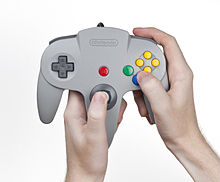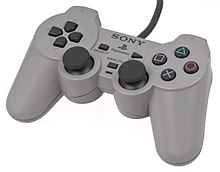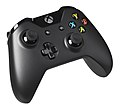Gamepad
A gamepad (also a joypad or controller ) is an input device for controlling computer games and a type of game controller . This is held with both hands and in its simplest form has a control pad on the left (up, down, left, right) and a row of action buttons on the right. D-pad and action buttons are assigned differently depending on the game, mostly with jumping or shooting. The gamepad has been the typical input device for game consoles since the mid- 1980s , replacing the joysticks that were previously in use .
Development and background
The first input devices designed for games were paddles , with which, for example, the arcade machine Pong or the home console Odyssey (both 1972) were controlled. The first game console to be delivered with a gamepad was the Famicom from Nintendo in 1983 , which was marketed worldwide as the Nintendo Entertainment System (NES) from 1985 . The basic key arrangement of the NES controller (control pad on the left, function keys in the middle, action buttons on the right and - since the SNES controller - shoulder buttons) has been adopted for almost all gamepads. The number of action buttons has increased gradually.
Nintendo patented the shape of the control pad in 1985; in the USA this patent expired in 2005. Because of this, most of the older gamepad designs from other manufacturers have a slightly different shape.
The first gamepads were purely binary : like the cursor keys on the keyboard, the control pad only provides information about whether, for example, B. "to the left" was either pressed or not. Such gamepads were therefore quite unsuitable for games in which the strength of a control command is important in addition to the “whether” (e.g. car races or flight simulators ).
The joypad of the first Sony PlayStation , released in December 1994, added horns to enable better ergonomic hand posture
An extensive expansion of the functionality came in April 1996 with the controller for the Nintendo 64 (N64) and in June 1996 for the Sega Saturn , which for the first time had an analog stick for control. In addition, the N64's gamepad was the first to have an expansion slot. A Rumble-Pak could be used in these , which enabled force feedback , the vibration of the gamepad, called Rumble.
The PlayStation's DualShock controller, introduced in early 1998 , had two analog sticks. Its layout is still the model of conventional joypads today. The only differences are usually the swapping of the control pad and the left analog stick, or variations in the number and arrangement of the buttons.
The Dreamcast , released in western climes in 1999, offers 2 expansion slots. If you have a VMU - memory card inserted into the slot 1, you have a second display are displayed directly on the controller, on the more or less relevant performance data.
The Nintendo Wii game console, introduced in 2006 , does not come with a conventional gamepad. The Wii remote control , on the other hand, masters motion control : the input device detects movements, rotations, position and position of the controller and enables commands to be triggered by movements. Since almost all genres use analog sticks, action buttons and the control pad , the majority of the games also use the Wii-FB as a conventional gamepad - these control options are also offered in combination with the Nunchuk . When held horizontally, the button arrangement on this controller is reminiscent of that of the NES game pad; various games can only be played in this way.
Gamepads over time
Sega Mega Drive game pads with three (left, 1988) and six (right, 1993) buttons
Atari Jaguar -Gamepad "PowerPad" (1993)
First PlayStation joypad (1994)
Nintendo 64 controller (1996)
DualShock for the PlayStation (1998)
DualShock 2 for the PlayStation 2 (2000)
Nintendo GameCube Controller (2001)
Xbox 360 controller (2005)
Wii : Wii Remote (right) and Nunchuk (left) (2006)
DualShock 3 for the PlayStation 3 (2007)
Wii U GamePad (2011)
DualShock 4 (2013)
Xbox One Controller (2013)
Joy-Con (2017)
use
The domain of the gamepad are game consoles. PC games, in which many functions have to be controlled, such as real-time strategy games , or require particularly high precision with regard to the absolute positioning of the cursor / crosshair, such as first-person shooters , are often designed to be controlled with keyboard and mouse . Games that, on the other hand, require precision with regard to steering deflections, such as flight simulators and racing games, are preferred with specialized input devices such as B. Joysticks and steering wheels controlled, which allow an analog acquisition of the control.
literature
- Winnie Forster , Stephan Freundorfer : Joysticks. Take 2 Interactive, 2004, ISBN 3-00-012183-8 .
Web links
- Chris Kohler (May 13, 2005): Controller's History Dynamite (English) , 1UP .
Individual evidence
- ↑ U.S. Patent 4,687,200
- ↑ Dominic Eskofier: Gamepad patents and the control pad. www.gamesaktuell.de, August 9, 2011, accessed on January 9, 2017 .
- ↑ http://www.scei.co.jp/corporate/data/bizdatajpn2004_e.html ( Memento from June 29, 2013 in the Internet Archive )
- ↑ http://www.gamona.de/games/spielekultur,die-evolution-des-controllers:pictureshow,2130488,screenshot-2130506.html
- ↑ http://www.gamona.de/games/spielekultur,die-evolution-des-controllers:pictureshow,2130488,screenshot-2130540.html



















